
More to it than BTUs
By George A. Olah
Features Tech tipsCanadian rental companies have a myriad of temporary heating appliances to choose from. Whatever heating product is decided upon, it is essential that it is approved by the relevant safety authorities in your particular part of the country
Canadian rental companies have a myriad of temporary heating appliances to choose from. Whatever heating product is decided upon, it is essential that it is approved by the relevant safety authorities in your particular part of the country. Whether powered by electricity, oil, propane or natural gas it is the rental company’s responsibility to buy and provide approved appliances for rental.
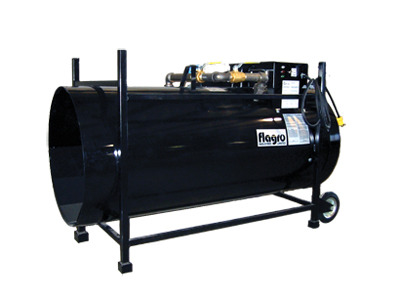 |
|
| Direct-fired heaters are usually found in popular BTU output sizes of around 100,000 to 1.5 million BTUs.
|
Price alone must not be the ultimate motivating factor when purchasing your rental equipment. Select a sales person and company able to provide you with technical support, warranty service and speedy access to replacements parts. Before purchasing a new piece of equipment for your rental fleet, ascertain whether or not there will be someone you can contact and who is able to provide information and the necessary parts to keep your heaters operational. Many heater manufacturers and equipment distributors provide product training on use and maintenance of their equipment – so ask.
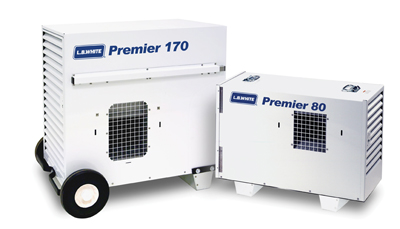 |
| The direct-fired tent heater is a rectangular boxy-looking piece of equipment normally painted white, very easy to set up and extremely quiet to operate. They usually employ electrically operated blowers and are fuelled by propane or natural gas. Advertisement
|
There are several varieties of construction heaters to choose from. As a rental company you will have to know and anticipate the requirements of your customers before you add heaters to your rental fleet. Most renters have their preferred heater sizes, fuel types, brand names or select heaters based on safety and regulatory requirements for a particular project. Be mindful that many jurisdictions favour and indeed require the use of indirect-fired heaters versus direct-fired heaters for temporary heat applications.
Perhaps the oldest type of construction heater is the venerable direct-fired heater (smaller units are nick named salamanders). These heaters are available from many different manufacturers produced in various shapes, sizes and qualities. They are usually found in popular BTU output sizes of around 100,000 to 1.5 Million BTUs and (even higher ranges for specialized uses). They are well-liked by customers because they have fewer parts, simply designed, reliable and easy to use. However, these units are often noisy. Both the heated air and products of combustion are exhausted through the same outlet. When these appliances are activated indoors, proper ventilation must be provided for at all times.
Smaller versions of direct-fired heaters (with lower heating output values) are commonly referred to as pot heaters (because of their shape) and are popular with both winter sports enthusiasts and building subcontractors alike. As with the larger direct-fired units, training is key and more often than not required by law before they can be connected, activated and disconnected.
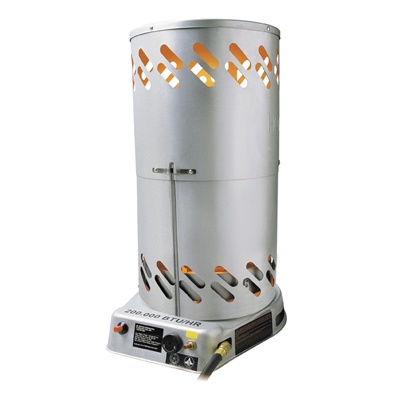 |
| Smaller versions of direct-fired heaters with lower heating output values are commonly referred to as pot heaters and are popular with both winter sports enthusiasts and building subcontractors. |
Radiant heaters are yet another type of direct-fired heater. Heating output sizes (model to model) range from a few thousand BTUs to over 100,000 BTUs. These are heating appliances that radiate heat from a shielded heater core. Some fit on top of 20 pound propane cylinders; others stand alone. They come in various physical sizes and fuel types. Radiant heaters provide dry heat and are extremely quiet and efficient to operate. Take note that some need special filters requiring additional instructions to the customer and cost (for replacement filters). Certain radiant heaters are meant only for very causal uses such as providing temporary heat for a fishing hut or workshop in a garage while others are much more robust and heavy duty for full time winter construction applications.
A favourite direct-fired heater is the elegant tent heater. It is a rectangular boxy looking piece of equipment normally painted white, very easy to setup and extremely quiet to operate. Tent heaters usually employ electrically operated blowers and are fuelled by propane or natural gas. They can also be used for ventilation as well as providing heat. Unlike a salamander no open flame is visible. Make sure that when you rent these out to your customers that you provide them with the appropriate ducts whether flexible or rigid. Depending on the size of the tent, you can use several compact tent heaters or even larger size indirect-fired units – some models being oil-fired. Tent heaters can also be used to supply temporary heat for apartment and town house renovation projects without the accompanying noise of traditional direct-fired units.
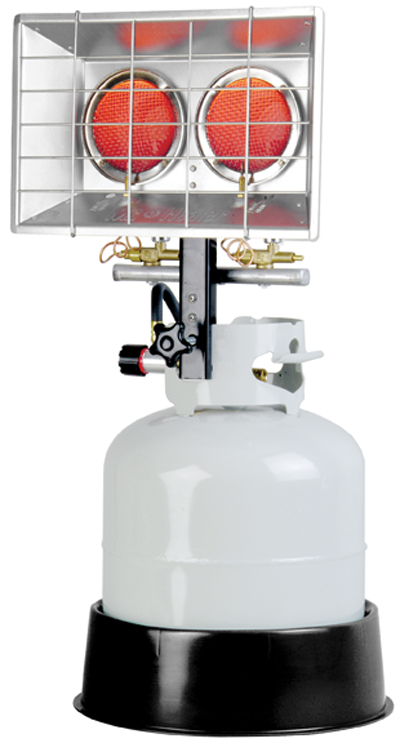 |
| Radiant heaters, another type of direct-fired heaters, outputs ranging from a few thousand BTUs to over 100,000 BTUs. These are heating appliances that radiate heat from a shielded heater core. |
The ubiquitous patio heater is essentially a thermostatically controlled small radiant heater mounted on a pole with a metal umbrella type heat reflector fuelled by propane or natural gas. They are available in a variety of heating ranges, physical sizes and build qualities. It is one thing to have one stand or installed in your backyard patio for casual use. It is quite another to have one dissembled time and time again and moved around from site to site and to expect no damage to occur to them. So look for durability when purchasing patio heaters for rental service. Remember not to rent them out to heat tents! Always ask your patio heater supplier whether they will carry a readily available inventory of replacement parts for the model you may be purchasing.
An indirect-fired construction heater is an appliance utilizing some type of heat exchanger with an electric fan moving the air over the exchanger/plenum while directing the warm air through some form of duct arrangement metallic or fabric. There is no open flame and the noise from the appliance is greatly reduced. It is similar to a forced air furnace found in millions of homes in Canada. The difference being that these indirect-fired construction heaters are portable and for temporary use. When set up properly on the job site these heaters have many positive environmental benefits since the exhaust from the appliance is vented directly outside to the atmosphere and not inside the structure under construction. Indirect-fired products, while more expensive when compared to direct-fired units on a BTU to BTU basis, are becoming more and more popular with rental companies and safety authorities across the country.
Regardless of your choice of temporary heater, there are some general considerations applicable to all of them. When selecting your product, look for: simplicity of operation, ease of maintenance, level of product complexity, presence of built-in handling hooks, sizing of the wheels, the quality of the paint finish, available accessories and overall size. Not every rental company has a fleet of self loading heavy duty trucks available to ferry the heaters to and from a site. Ask yourself how easily or not the heater unit fits and loads and unloads on your pick-up truck or trunk of a renter’s vehicle? Keep in mind that not all heaters can be conveniently switched from propane to natural gas or natural gas to propane use. There are some heater models that can be easily changed between several fuel types including oil with a flip of a lever while others require a qualified mechanic to safely complete the task.
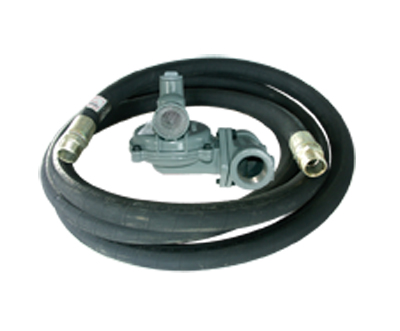 |
| Customers using propane or natural gas as a fuel need a qualified installer to set up the equipment with the right capacity and length of hose or piping and the appropriately sized regulators. |
When heaters do not operate properly it is not necessarily the fault of the manufacturer, the product distributor or the sales person who sold it to you. One cause for customer product dissatisfaction is the improper use of power cords. Not using the correctly rated, and length of, electrical extension cord attached to the appropriately rated power supply causes many needless customer calls and expensive service visits. Be sure to instruct your customers how to utilize the proper power cords.
If your customer is using propane or natural gas as a fuel, ensure that a qualified installer sets up the equipment with the right capacity and length of hose/piping and the appropriately sized regulators. For instance, while most propane hoses are black in colour and have brass ends, a 50 foot half inch hose will not power a 1.5 million BTU direct-fired heater for long or even at all. And remember too, that all hoses used for gaseous fuels must have the appropriate approval labels attached – at all times.
Customers should know what use the heating appliance they are renting is designed for. Confirm all potential uses of your product with your equipment supplier or manufacturer. Patio heaters are for heating patios and not garages or tents. You cannot heat your fishing cabin with a salamander expecting to wake up in the morning refreshed and ready to go because most likely you won’t wake up at all. And you don’t heat pizza or your lunch sandwich on top of your radiant heater because it is a space heater and not a micro wave. Moreover, melted cheese is not good for the efficient operation of a stainless steel heater core.
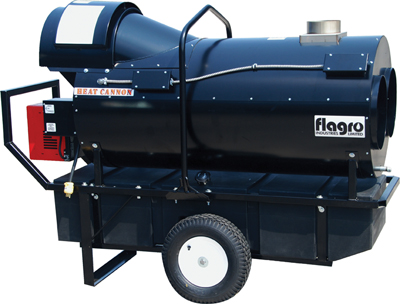 |
|
| There is no open flame from indirect-fired construction heaters and the exhaust is vented directly outside. While more expensive compared to direct-fired units, they are becoming more popular with rental companies.
|
Don’t oversell the size of the heater (and number of heaters) to your customer. Small construction jobs typically do not require 1.5 million BTU direct-fired units or 400,000 BTU indirect-fired units when a small 150,000 BTU salamander type or 100,000 BTU radiant heater will adequately and cost effectively handle the job. Often, economical air movers can be added to a site without the need of additional heaters to increase the flow of heated air.
Inform your customer that certain equipment may require the frequent changing of oil or air filters to operate properly or from shutting down in middle of a plastering job or concrete pour. Don’t forget to leak test the connections on gaseous fuelled equipment. This cannot be done casually using the human nose or lit butane lighter as a leak detector. As well, always follow the manufacturer’s use directions for set-back distances for the heater from flammable sources. Do not throw away the manufacturer’s manuals – it is a reference document.
 |
|
| George Olah. |
Temporary construction heaters will provide years of reliable rental duty when maintained and utilized in accordance with regulatory requirements and the manufacturer’s instructions. There are many types, excellent brands and sizes to choose from operating on a variety of fuels. Fit the choice of heater to the appropriate job at hand and always remember that there is no substitution for proper training and qualified technicians to ensure that the job is completed safely and to the satisfaction of the customer.
*George A. Olah has over 35 years of experience marketing commercial appliances in the North American marketplace. He is presently providing consulting services to Diversco Supply in Cambridge, Ont.
Print this page
Leave a Reply